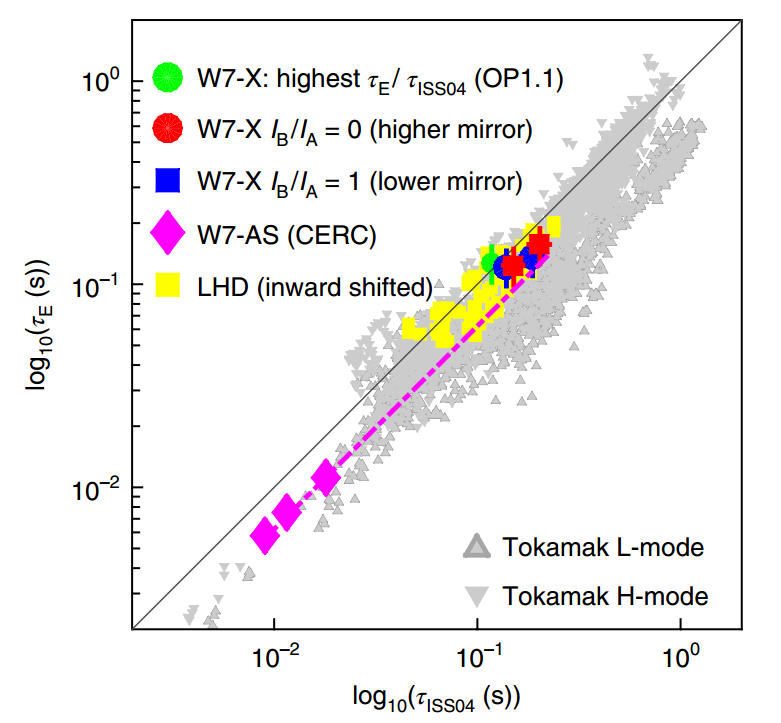The Wendelstein 7-X stellarator has proven to be effective.

On the thermonuclear reactor type "stellarator" on Geektimes wrote several times. Sometimes the conversation was about a very specific stellarator - Wendelstein 7-X . At the moment it is the largest system of this type, which only recently passed a number of tests. Upon their completion, it turned out that the reactor requires a little refinement, so it had to be decommissioned and improvements started.
The process is not yet complete, but some early tests have shown that the effectiveness of the Wendelstein 7-X is high. Scientists involved in the creation of the stellarator, believe that it is too early to celebrate, but their confidence in them has increased markedly.
The stellarator itself was built at the Max Planck Institute for Plasma Physics in Graiswald. Behind the project are scientists who are confident that without the development of the technology for producing thermonuclear fusion energy, humanity is doomed. Indeed, only 1 gram of deuterium and tritium can produce 90,000 kWh of energy, which is equivalent to burning 11 tons of coal.
')
Recently, a scientific work was published describing the results of the stellarator tests for the previous two years. As it turned out , the scientists were able to reduce the amount of current in the plasma cord (in the stellarator, this current is harmful, unlike tokamaks) four times as compared to tokamaks. In general, scientists managed to bring the plasma confinement time to 160 milliseconds. At the moment, this is the best result among the stellarators.
After finishing the system, the specialists hope to keep the plasma much longer than in stellarators or tokamaks until now. Experts believe that the next generation of stellarators can achieve a hold time of about 30 minutes. This is if the diverter cooling will work as expected by scientists.

In general, in experiments, plasma showed the uniform density required by scientists, which allows stabilizing the process of a thermonuclear reaction and increasing its duration. Now the cooling system is being finalized. As soon as everything is ready, the scientists will again “start” the stellarator and continue its tests.
As is well known, thermonuclear fusion (controlled) differs from the method of producing energy in a traditional nuclear reaction primarily in that in the latter case, the nuclei of heavy elements are broken, producing lighter ones. In synthesis, the opposite is true. Now, unfortunately, humanity is unable to obtain energy from the reaction of thermonuclear fusion. All that is - these are hydrogen bombs, which are much more powerful than ordinary atomic bombs and tokamaks with stellarators, experimental reactors, which scientists hope will sooner or later give a huge amount of energy.
In principle, tokamaks are also being improved, but some experts believe that the future lies precisely with the stellarators. Both the first and the second group give quite logical arguments, show their calculations, which deserve attention. But power engineers will judge only time.
Wendelstein 7-X is the most complex experimental system. Scientists aim to prove that controlled thermonuclear fusion is capable of producing energy. So far, some scientists have questioned this.

Schematic representation of the stellarator
The stellarator was created by American astrophysicist Lyman Spitzer in 1958. The first sample of such a reactor appeared in 1959 in the United States. Its design is very different from the design of the tokamaks, for which scientists from the USSR actively advocated. The basis of the design of tokamaks is toroidal chambers with magnetic coils. The plasma cord is held by the toroidal field of the external magnetic coils, as well as by the poloidal field , which is created by the current flowing through the plasma. In order for a fusion reactor of this design to work, the current in it must be constantly maintained. This is possible, although it is very difficult to do.
Wendelstein 7-X consists of 50 superconducting coils about 3.5 meters high. Total weight - 425 tons. The coils create a magnetic field with an induction of three tesla, which makes it possible to hold the plasma with a temperature of more than 60 million degrees.
DOI: 10.1038 / s41567-018-0141-9
Source: https://habr.com/ru/post/374533/
All Articles